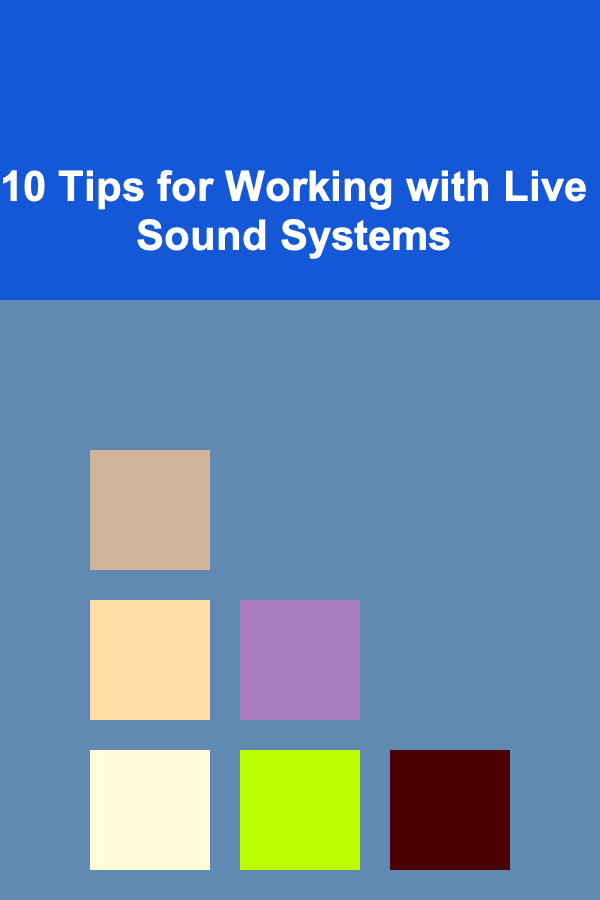
How to Create a Minimalist Home with Effective Storage Solutions
ebook include PDF & Audio bundle (Micro Guide)
$12.99$7.99
Limited Time Offer! Order within the next:

Creating a minimalist home is more than just a design aesthetic---it's about simplifying your living space, reducing clutter, and focusing on what truly matters. In the world of interior design, minimalist spaces are often seen as serene, functional, and easy to maintain. At the heart of minimalism lies the concept of "less is more," where every item serves a purpose, and every space is designed with intention.
Effective storage solutions are key to creating a minimalist home. Without proper storage, it becomes challenging to maintain a clean, organized environment. In this article, we will explore how to design a minimalist home with a focus on maximizing storage efficiency. From decluttering your space to implementing smart organization techniques, we'll cover how to achieve a minimalist lifestyle without sacrificing comfort or functionality.
Understanding Minimalism in Home Design
Minimalism in home design is about more than just sleek furniture and white walls. It's a lifestyle choice that prioritizes simplicity and clarity. The primary goal of minimalist home design is to create a space that is calm, organized, and functional by eliminating unnecessary items and focusing on essentials.
Core Principles of Minimalism:
- Simplicity: The focus is on clean lines, neutral colors, and streamlined designs that create a calm and uncluttered environment.
- Functionality: Every item in a minimalist home should serve a clear function. There's no room for unnecessary decorations or redundant furniture.
- Quality over Quantity: Minimalism encourages investing in high-quality, long-lasting items rather than accumulating things that are not essential.
- Decluttered Spaces: A minimalist home should be free from clutter. This doesn't mean empty spaces but rather, spaces where everything has a designated place, and nothing is superfluous.
Now that we understand the essence of minimalist design, let's look at how you can transform your home into a minimalist sanctuary, beginning with effective storage solutions.
Decluttering Your Home
The first step in creating a minimalist home is to declutter. This can be a daunting task, especially if you've accumulated years' worth of belongings. However, decluttering is essential to achieving a clean, organized space. Here are some steps to guide you through the process:
1. Start with One Area
Rather than trying to declutter the entire home at once, focus on one area at a time. This could be a room, a closet, or even just a drawer. By breaking the task into smaller sections, you can approach it with a clear goal and avoid feeling overwhelmed.
2. The "Four-Box" Method
The "Four-Box" method is an effective way to declutter. For each area you are organizing, label four boxes:
- Keep: Items you use regularly or truly love.
- Donate: Items that are still in good condition but are no longer needed.
- Sell: Items that have value and can be sold.
- Trash: Items that are broken, damaged, or no longer serve any purpose.
This method helps you assess your belongings and make decisions about what to keep and what to part with.
3. Be Ruthless with Your Belongings
Minimalism is about quality over quantity. Be honest with yourself about what you truly need. It's easy to hold onto items because they have sentimental value or because you think you might use them someday. However, in a minimalist home, every item should serve a purpose. If an item doesn't fit this criterion, it may be time to let it go.
4. Digital Declutter
Decluttering is not just about physical items. In today's digital age, we often accumulate a significant amount of digital clutter. This includes files, photos, and apps that take up space on our devices. Make a habit of organizing your digital space by sorting files, deleting unneeded ones, and unsubscribing from unwanted emails or apps.
Creating Effective Storage Solutions
Once you've decluttered your home, the next step is to implement effective storage solutions that support your minimalist lifestyle. Here are several strategies to help you store your items efficiently while maintaining a minimalist aesthetic:
1. Maximize Vertical Space
In many homes, floor space is limited, but vertical space is often underutilized. Make use of the walls by adding shelves, hooks, and cabinets that can hold items without taking up valuable floor space. For example, installing floating shelves in the living room or kitchen allows you to store books, decor, or kitchen essentials without cluttering countertops or tables.
- Wall-mounted storage: Wall-mounted shelves or cabinets are perfect for holding things like books, plants, or artwork.
- Pegboards: Pegboards are a versatile and visually appealing option for organizing small items like tools, craft supplies, or kitchen utensils.
2. Use Multi-Functional Furniture
In a minimalist home, furniture should serve more than one purpose. Multi-functional furniture is a game-changer in small spaces. By investing in pieces that have more than one function, you can reduce the number of items in your home, while still meeting your needs.
- Sofa beds: A sofa that converts into a bed is perfect for small apartments or guest rooms.
- Storage ottomans: An ottoman that doubles as a coffee table and provides hidden storage space for blankets or magazines.
- Fold-out desks or tables: A desk or table that can be folded up when not in use saves space in a home office or dining room.
3. Maximize Closet Storage
Closets are often the main source of clutter in a home, especially if they're not well-organized. By optimizing your closet storage, you can keep clothes, shoes, and accessories neatly tucked away, reducing the visual clutter in your living spaces.
- Use closet organizers: Invest in drawer dividers, baskets, and hooks to maximize closet storage. This will help you keep items organized and easy to find.
- Seasonal rotation: If you have limited closet space, rotate your wardrobe seasonally. Store out-of-season clothes in bins or under the bed to free up space for the current season's items.
- Hanging organizers: Use hanging organizers for shoes, scarves, or bags. These are excellent for keeping items organized while maximizing vertical closet space.
4. Utilize Hidden Storage
In a minimalist home, hidden storage is key to maintaining a clean, clutter-free environment. Items should be stored out of sight to keep surfaces clear. Here are some ways to incorporate hidden storage into your home:
- Under-bed storage: Use storage bins or drawers under the bed to store off-season clothing, extra linens, or shoes.
- Built-in furniture: Custom furniture pieces with built-in drawers or cabinets can be used to store things like electronics, books, or clothing without sacrificing floor space.
- Hidden compartments: Consider investing in furniture that offers hidden compartments, like a coffee table with a storage drawer or a console table with built-in storage.
5. Declutter Your Kitchen
The kitchen is often one of the most cluttered rooms in a home due to the number of gadgets, dishes, and utensils we accumulate over time. By employing efficient storage solutions, you can keep your kitchen organized while maintaining the minimalist vibe.
- Drawer dividers: Use dividers in kitchen drawers to keep utensils and tools organized. This reduces visual clutter and makes it easier to find what you need.
- Magnetic storage: A magnetic strip or board can be used to store knives, tools, or spice jars, keeping countertops clear and free of clutter.
- Pull-out cabinets: Invest in pull-out cabinets or pantry shelves to store dry goods or kitchen tools. This allows you to organize your kitchen in a way that's efficient but doesn't take up valuable space.
6. Keep Surfaces Clear
In a minimalist home, surfaces should be kept as clear as possible. This means that tables, countertops, and shelves should only have essential items, such as a few carefully chosen decorative pieces or functional items like lamps or trays.
- Declutter regularly: Make a habit of regularly clearing off surfaces, especially those that tend to collect random items. Create a system where everything has its designated place.
- Functional decor: Instead of decorative items that serve no function, choose pieces that have a purpose. For example, a beautiful tray or bowl can serve as a catch-all for keys or mail while still adding to the decor.
Implementing a Sustainable Minimalist Lifestyle
While effective storage solutions can help you create a minimalist home, maintaining a minimalist lifestyle requires a conscious effort to buy less and live more intentionally. Here are some tips for living sustainably in a minimalist home:
1. Adopt the One-In, One-Out Rule
The one-in, one-out rule is a simple but effective strategy for maintaining a clutter-free home. For every new item you bring into your home, remove one item that you no longer need. This ensures that your possessions don't accumulate over time and helps you maintain a minimalist lifestyle.
2. Invest in Quality Items
Instead of buying cheap, disposable items, focus on purchasing high-quality, long-lasting products. This applies to everything from furniture to kitchen gadgets. High-quality items tend to last longer and serve their purpose more effectively, reducing the need for frequent replacements.
3. Be Mindful of Consumption
Minimalism is not just about decluttering your home---it's about reducing overall consumption. Be mindful of what you buy and ask yourself whether the item truly serves a purpose in your life. Avoid impulse purchases and prioritize items that add value to your space and your lifestyle.
4. Maintain Regular Decluttering Habits
Minimalism is an ongoing process, not a one-time event. Regularly revisit your belongings and assess whether they still serve a purpose. Make decluttering a routine practice to ensure that your home remains organized and clutter-free.
Conclusion
Creating a minimalist home with effective storage solutions is about more than just cutting back on your belongings. It's about designing a space that is functional, organized, and free from unnecessary clutter. By decluttering your home, investing in smart storage solutions, and adopting a minimalist mindset, you can create a serene, peaceful living environment that supports your lifestyle and promotes mindfulness.
Minimalism offers more than just aesthetic appeal; it provides clarity, reduces stress, and enhances the overall quality of life. By focusing on what truly matters and eliminating the excess, you can create a home that reflects your values and helps you live more intentionally. With the right storage strategies, a minimalist home can be both beautiful and functional, providing the perfect environment for rest, relaxation, and meaningful living.
Reading More From Our Other Websites
- [Home Soundproofing 101] How to Soundproof Your Bedroom for Better Sleep and Privacy
- [Mindful Eating Tip 101] Best Seasonal Recipes That Encourage Mindful Eating of Local Produce
- [Whitewater Rafting Tip 101] Getting Started with Rafting: Essential Gear and Safety Tips
- [Home Holiday Decoration 101] How to Stay Ahead of the Curve with Emerging Holiday Decor Trends
- [Personal Care Tips 101] How to Use Mouthwash to Reduce Plaque Build-Up
- [Hiking with Kids Tip 101] Exciting Nature Scavenger Hunt Themes Your Kids Will Love
- [Personal Financial Planning 101] How to Track Your Expenses Without Getting Overwhelmed
- [Home Lighting 101] How to Light a Walk-in Closet for Easy Visibility and Organization
- [Organization Tip 101] How to Use Mirrors to Enhance Shoe Display Areas
- [Scrapbooking Tip 101] DIY Paper Techniques: Adding Texture and Depth to Your Layouts

How to Create a Sports Equipment Budget for New Purchases
Read More
How to Use Rugs to Update Your Home on a Budget
Read More
How to Practice Non-Violent Communication
Read More
How to Master Options Spreads
Read More
How to Build an Investing To-Do List for Beginners
Read More
10 Tips for Working with Live Sound Systems
Read MoreOther Products

How to Create a Sports Equipment Budget for New Purchases
Read More
How to Use Rugs to Update Your Home on a Budget
Read More
How to Practice Non-Violent Communication
Read More
How to Master Options Spreads
Read More
How to Build an Investing To-Do List for Beginners
Read More